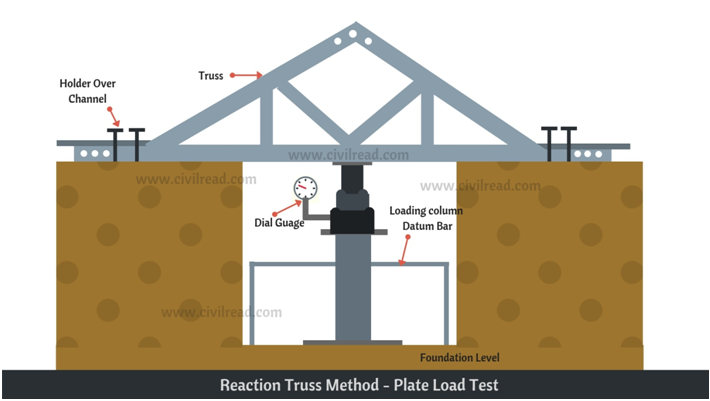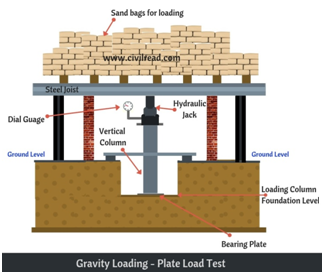Plate Load Test:-
Plate load test is performed to determine the ultimate load bearing capacity of soil over the in-situ conditions. The plate load test is mandatory in case of designing foundation over the sandy and clayey soil. This test gives the highest rate of accuracy determining the safe bearing capacity of soil in case of shallow foundations.
This test determines the Ultimate Bearing capacity of Soil, Settlement of foundation & Allowable bearing pressure of soil. Plate load test is suitable for Cohesionless soil as in case of Cohesion soil the settlement takes place in longer duration which this test is not suitable.
In this test, the square rigid plate having dimensions 300mm x 300mm or Circular rigid plate having dia 300mm (larger dia plates may also used if the soil is in very loose condition) is placed on a foundation and load is applied in increments on the plate with the help of hydraulic jack. Then the settlement per each load increment is recorded to calculate the bearing capacity of the soil. This test is also known as Plate bearing test.
Plate load test is performed under two variations:
1) Gravity load test (Reaction Loading method)
2) Reaction truss method
The total duration required to perform a complete test varies from 6-7 days which includes installations, test, dismantling. The results of the test in case of soft strata can be obtained within a few hours whereas in case of hard strata it might take close to a couple of days.
Plate Load Test:-
1.Gravity load test
In this type of method, a rigid platform is utilized to transfer loads through loading of sandbags or concrete blocks. These blocks and sandbags act as a dead weight, and whole arrangement rests upon vertical columns. The hydraulic jack is provided in between the rigid plate and top of the column to transfer the load properly.
2.Reaction truss method :
In this method, the reaction generated through jack is borne by reaction truss installed over it. The undesirable movement of truss is controlled by soil anchors or nails fixed into the soil with the help of hammers. The most commonly observed truss is made of mild steel sections. In order to curb later movement, truss is locked with guy ropes.
Sheltera has the capacity of carrying out the Pile Load Test ranging from 0-1000ton.
Sheltera has the capacity of carrying out the Pile Load Test ranging from 0-1000ton.





